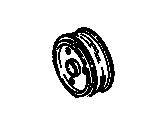
My Garage
My Account
Cart
Genuine Pontiac Fiero Crankshaft Pulley
Crankshaft Pulley Engine Harmonic Balancer- Select Vehicle by Model
- Select Vehicle by VIN
Select Vehicle by Model
orMake
Model
Year
Select Vehicle by VIN
For the most accurate results, select vehicle by your VIN (Vehicle Identification Number).
2 Crankshaft Pulleys found
Pontiac Fiero Crankshaft Pulley
The Performance Crankshaft Pulley invested in Pontiac Fiero automobiles is also an important element in enhancing the performance of the engine as it regulates the power delivery to other parts including the power steering pump, Air conditioning compressor and the alternator. This pulley is also known as the harmonic balance wheel and is mechanically connected to the engine crankshaft so that the engine can use torque and at the same time,control engine oscillations. There have been different types of Performance Crankshaft Pulley that has been used in Pontiac Fiero models and all of them has been developed with a purpose of improving performance. These pulleys differ mainly in their manufacturing and its mass, which in its turn influences the sensitivity and efficiency of the engine. Hence, enhancing power delivery and the elimination of unnecessary vibrations makes the Performance Crankshaft Pulley so advantageous for a Pontiac Fiero model to drive on the road.
Each OEM Pontiac Fiero Crankshaft Pulley we offer is competitively priced and comes with the assurance of the manufacturer's warranty for the part. Furthermore, we guarantee the speedy delivery of your orders right to your doorstep. Our hassle-free return policy is also in place for your peace of mind.
Pontiac Fiero Crankshaft Pulley Parts Questions & Experts Answers
- Q: How to remove and install the crankshaft pulley and oil seal in four cylinder engine on Pontiac Fiero?A:Remove the cable from the negative battery terminal, then loosen the accessory drivebelt tension adjusting bolts and remove the drivebelts, tagging each belt for easier reinstallation. Jack up the vehicle and secure it on jackstands before removing the right rear wheel. Take out the right rear inner fender splash shield by pulling out the plastic pop fasteners, as this is necessary to access the crankshaft pulley. If equipped with a manual transaxle, apply the parking brake and put the transaxle in gear to prevent the engine from turning over, then remove the crank pulley bolts. For vehicles with an automatic transaxle, remove the starter motor and immobilize the starter ring gear with a large screwdriver. A breaker bar may be needed due to the tightness of the bolts. To loosen the crankshaft hub retaining bolt, thread a bolt into one of the pulley bolt holes, place a large breaker bar and socket on the retaining bolt, immobilize the hub with a large screwdriver, and then remove the bolt. Remove the crank hub, using a puller if necessary, and carefully pry the oil seal out of the front cover with a large screwdriver, taking care not to damage the cover. Install the new seal with the lip toward the engine, driving it into place with a seal installation tool or a large socket. Apply a thin layer of multi-purpose grease to the seal contact surface of the hub, position the pulley hub on the crankshaft nose, and ensure it aligns with the Woodruff key. Use the crankshaft hub bolt to press the hub into position and tighten it to the specified torque. Install the crank pulley on the hub, applying thread locking compound to the pulley-to-hub bolts before installation, and finally reinstall the drivebelts and the right rear inner fender splash shield.













